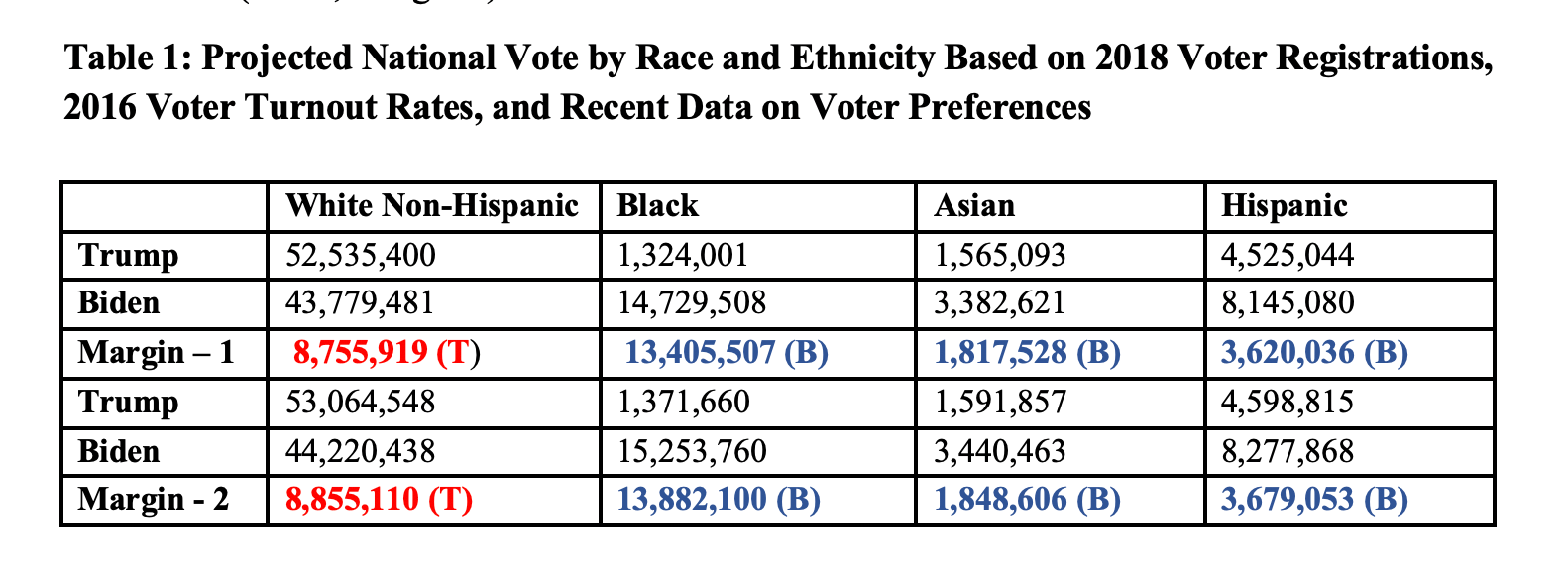
White Voters Are Turning Away from Donald Trump
Donald Trump’s heated racial appeals betray his growing political problem with white voters. Trump is running far behind Joe Biden in national polls because, according to data from the Pew Research Center, his 20 percentage-point advantage with white voters in 2016 (57 percent to 37 percent) dwindled to nine points by mid-August of this year (54 percent to 45 percent). Trump’s deficit with Hispanic voters is actually less than in 2016, down from 38 to 28 percentage-points (35 percent to 63 percent). When it comes to Black and Asian-American voters he’s held steady since 2016. He faces an 80 percentage-point gap in support from Black voters (8 percent to 88 percent), as he did last time, and his 38-point deficit with Asian voters (27 percent to 65 percent) is also unchanged. Crunch the numbers and in a fair election, Biden would beat the president by at least 10 million votes today and carry four of the five swing states Trump won in 2016—Pennsylvania, Michigan, North Carolina and Florida Trump would hold on to Wisconsin under this scenario.
This assessment does not rest on typical polls of 800 or 1,200 people. People’s current preferences for Trump versus Biden by race and ethnicity and the 2016 vote by race and ethnicity are drawn from the Pew Research Center’s gold-standard survey of 11,000 registered voters.The projected vote this year by race and ethnicity also rests on voter registration and turnout data from the 3.5 million households who take part in the Census Bureau’s American Community Survey, its annual comprehensive measure of the population. Combining data of this breadth is a powerful lens on the electorate. And the electorate is not happy.
Drill down into woes with white voters: They provided about 90 percent of his support in a very close 2016 race. He cannot afford to lose any of them in November. On top of that, the most recent Census Bureau data (2018) show that since 2016, the absolute number of white Americans registered to vote also has fallen substantially. Trump’s law-and-order outbursts and clumsy efforts to demonize Biden may excite his educed base, but those tactics ignore the top concerns of both white and minority voters—the high and rising death toll from the pandemic and the three-fold increase in unemployment.
Trump’s 2016 victory rested on white Americans who dominated the 2016 electorate. Back then, 114.2 million whites were registered to vote, compared to 41.0 million Black, Asian, and Hispanic Americans. But from 2016 to 2018, the universe of registered white voters contracted by 4.1 million votes, while the ranks of registered Black, Asian, and Hispanic voters fell by only 560,000. The registration data also show that the number of registered college graduates, one of Biden’s strongest groups, increased by nearly 2 million to 60.4 million voters, while Trump’s strongest group, registered voters with high school diplomas or less, also contracted by 4.1 million to 46.2 million.
And if you register to vote but odds are you will turn out to vote. In 2016, 88 percent of registered white voters cast ballots in the presidential election, as did 87 percent of registered Black voters, 86 percent of registered Asian voters, and 83 percent of registered Hispanic voters. By contrast, the latest registration data show that 71 percent of eligible white voters were registered to vote in 2018 (down from 74 percent in 2016), compared to 64 percent of eligible Black Americans, 53 percent of eligible Asian Americans, and 54 percent of eligible Hispanic Americans.
The decline in white voter registration, Trump’s reduced support from white voters, and Biden’s overwhelming backing from minority Americans together present a daunting obstacle to a second Trump term.
We can project the likely vote if a fair election happened today. Using the 2018 voter registration data by race and ethnicity, the 2016 voting rates by race and ethnicity, and Trump and Biden’s support in mid-August by race and ethnicity, the outcome is catastrophic for the president.He would be expected to carry white voters by an 8.8 million vote margin while losing Blacks by 13.4 million votes, Asians by 1.8 million votes, and Hispanics by 3.9 million votes. In this accounting, Biden’s estimated popular vote margin in a fair election today would be nearly 10.1 million votes, in a 53.9-percent-to-46.1-percent race (Table below, Margin-1). If we distribute the small numbers of non-responders to the Pew Research Center’s survey, Biden would be expected to top Trump’s total number of votes in a fair election today by 10.6 million votes, in a 54.0-percent-to-46.0-percent race.
Of course, a presidential election is a competition for electoral votes, and not a popularity contest. So, we can apply the same analysis to the five critical swing states won by Trump in 2016—Florida, Michigan, North Carolina, Pennsylvania, and Wisconsin. We use each state’s 2018 voter registration data by race and ethnicity, each state’s 2016 voter turnout rates by race and ethnicity, and the Pew Research Center survey of support for Trump and Biden by race and ethnicity.
The results show Biden today winning four of the five swing states—all but Wisconsin—in a fair election today. In Florida, Biden would be expected to win by about 900,000 votes: Trump carries Florida’s white voters by a 485,000 margin, while Biden wins Florida Black voters by a 932,000 margin, Florida Hispanics by 402,000 votes, and Florida Asians by 49,00 votes. North Carolina is also a wipeout for Trump: He would be expected to carry the state’s white vote by a 296,000 margin and lose the state by 535,000 votes, because Biden is projected to carry Black North Carolina voters by a margin of 773,000 votes, the state’s Asian voters by 27,735 votes, and its Hispanic voters by 30,500 votes.
Michigan and Pennsylvania are closer, because 85 percent of the expected voters in those states are white, compared to 75 percent in North Carolina and 67 percent in Florida. So, in a fair election today, Biden would be expected to carry Michigan by 204,000 votes—by winning the state’s minority voters by 564,000 votes and losing Michigan white voters by a 360,000-vote margin. Similarly, Biden today would be expected to carry Pennsylvania by 106,000 votes despite Trump winning the state’s white voters by a 432,000-vote margin, because Biden’s expected margin from minority voters would be 538,000 votes.
Wisconsin is the only swing state that Trump should be expected to carry today in a fair election, primarily because whites comprise more than 91 percent of the state’s expected voters. By this analysis, Biden would carry Wisconsin’s minority voters by a 132,600-vote margin and lose the state by 91,000 votes because Trump would win Wisconsin white voters by a 224,000-vote margin. But in a fair election, the Biden-Harris ticket would not need Wisconsin’s electoral vote to defeat Trump-Pence.
In fact, in a fair election today, Biden would be expected to defeat Trump with support from 40 percent to 41 percent of white voters, albeit a narrower win. At 45 percent support, it would be a blowout.
Trump’s only seeming opening for a second term involves winning back a significant share of the white voters he has lost today over the mounting deaths and economic fallout from his mishandling of the COVID-19 pandemic. His last chance appears to require reversing and revising his entire approach to the pandemic. That may be a bridge too far for Donald J. Trump, even if it means his defeat.

 Of course, a presidential election is a competition for electoral votes, and not a popularity contest. So, we can apply the same analysis to the five critical swing states won by Trump in 2016—Florida, Michigan, North Carolina, Pennsylvania, and Wisconsin. We use each state’s 2018 voter registration data by race and ethnicity, each state’s 2016 voter turnout rates by race and ethnicity, and the Pew Research Center survey of support for Trump and Biden by race and ethnicity.
Of course, a presidential election is a competition for electoral votes, and not a popularity contest. So, we can apply the same analysis to the five critical swing states won by Trump in 2016—Florida, Michigan, North Carolina, Pennsylvania, and Wisconsin. We use each state’s 2018 voter registration data by race and ethnicity, each state’s 2016 voter turnout rates by race and ethnicity, and the Pew Research Center survey of support for Trump and Biden by race and ethnicity.